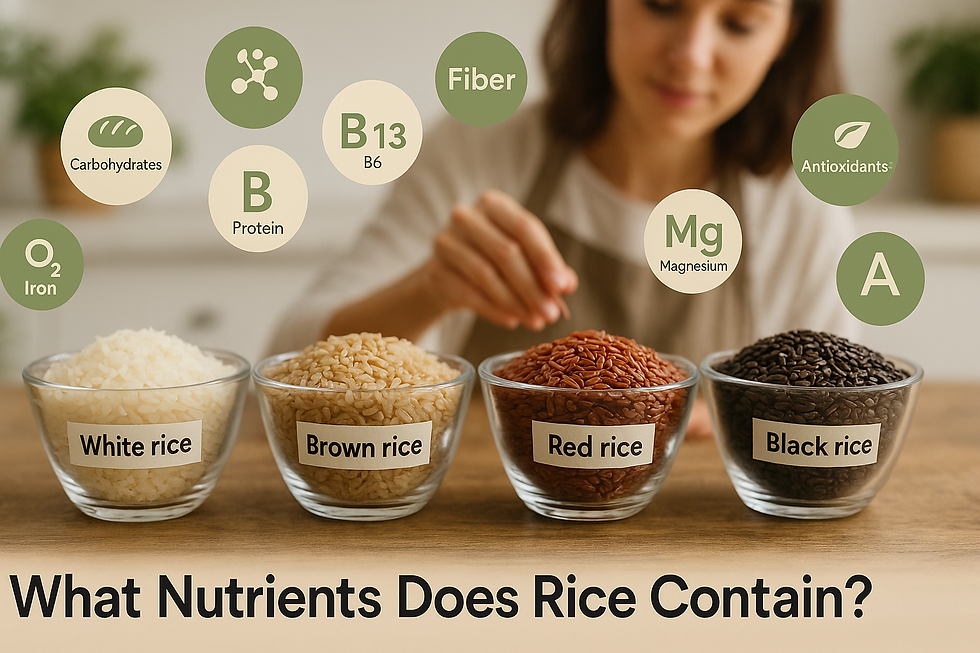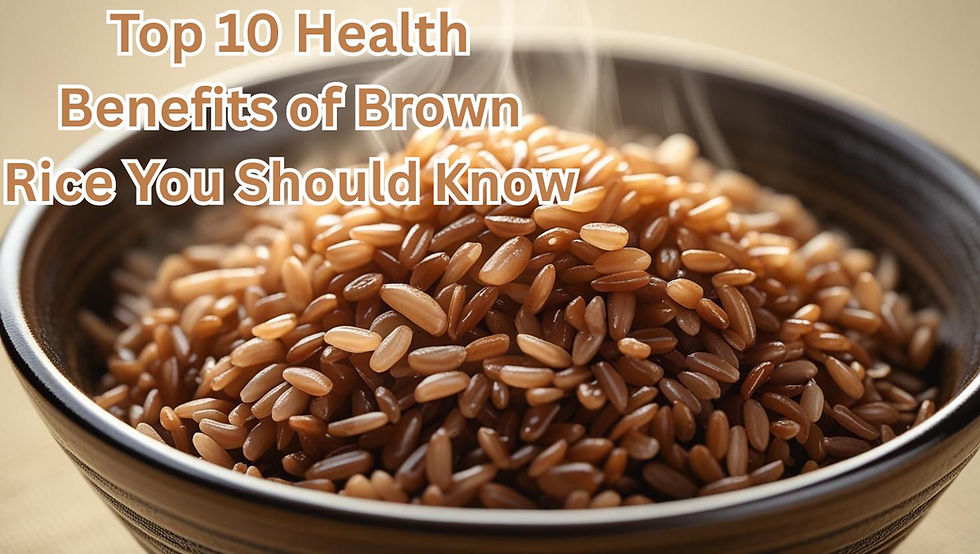What Nutrients Does Rice Contain?
- Rajan Magar
- Jun 30
- 5 min read

Rice is perhaps the most consumed staple food worldwide. From North India's fragrant Basmati Rice to Southeast Asia's clingy Jasmine Rice, rice has fed billions for centuries. Yet aside from its flavor and versatility, many ask: What does rice have in terms of nutrition, and how does it affect your health?
This book dissects the necessary nutrients in rice, delves into various rice varieties, emphasizes the health advantages of rice, and provides details regarding rice production and exportation, particularly from India, a world rice giant.
The Basic Nutrients Found in Rice
Rice, white, brown, basmati, or jasmine, has a number of essential nutrients that make it a healthy food choice. Depending on the type and processing method, rice is rich in the following:
1. Carbohydrates
Carbohydrates are the richest nutrient in rice. They deliver rapid energy to the body. Simple carbs are higher in white rice, whereas Brown Rice provides complex carbohydrates with slower energy delivery.
2. Protein
Rice provides a moderate quantity of protein, which is used for tissue repair and muscle development. Even though it's not a complete protein, when combined with legumes, you can achieve a balanced amino acid profile.
3. Fiber
Fiber is primarily present in whole grain forms such as brown or Indrayani Rice. Fiber aids digestion, avoids constipation, and maintains healthy blood sugar levels.
4. Vitamins
There are a number of B-vitamins present in rice, including:
Thiamine (B1) – required for metabolism and nerve function.
Niacin (B3) – aids energy production and skin health.
Vitamin B6 – is involved in brain and immune system health.
Fortified rice crops can also include folate and other supplement vitamins.
5. Minerals
Rice has essential minerals naturally:
Magnesium – aids in heart and muscle function.
Phosphorus – essential for bones and teeth.
Selenium – an antioxidant that prevents cell damage.
Manganese – aids in bone development and nutrient uptake.
6. Antioxidants
Brown and pigmented rice (such as red or black rice) are high in antioxidants. These substances assist in combating free radicals and curbing inflammation throughout the body.
Various Types of Rice and Their Nutritional Values
There are over 40,000 types of rice, but some of the most common and nutritionally different varieties include:
1. Basmati Rice
Basmati Rice is famous for its long grain, smell, and fluffiness. It is high in carbohydrates and has a lower glycemic index than plain white rice. Therefore, it is highly sought after by diabetics and health buffs.
2. Jasmine Rice
Well-known in Thai cooking, Jasmine Rice is soft and clingy. It provides instant energy from its high content of carbohydrates, though it's less fiber-rich than whole-grain rice.
3. Brown Rice
This is rice in its most natural state, with the outer hull removed only. Brown rice contains the bran and germ, and so is higher in fiber, vitamins, and minerals. It's great for heart health and cholesterol control.
A delicious and slightly sticky rice cultivated in Maharashtra, India. It is famous for its tender texture and nutritional density. Being a less processed rice, it has more fiber and micronutrients compared to polished rice.
5. Kepsa Rice
Kepsa rice is generally long-grain rice utilized for Middle Eastern and South Asian cuisine. It's particularly ideal for recipes that call for fluffy, separated grains. It provides good energy, with moderate protein and essential nutrients.
Each of these rice varieties has its own specific nutritional makeup, yet they all offer vital energy and health benefits when eaten as part of a balanced diet.
Health Benefits of Rice
Rice is more than a taste and a tradition—it has several health benefits that make it a staple in diets around the globe.
1. Energy Booster
Due to its high content of carbohydrates, rice is a speedy and effective source of energy, perfect for sportspeople and physically active persons.
2. Aids Digestive Health
Whole grain rice such as brown and Indrayani has high fiber content, which is effective in ensuring digestive health and avoiding constipation.
3. Gluten-Free Option
Rice is gluten-free by nature, and thus it can be consumed safely and healthily by individuals suffering from celiac disease or gluten intolerance.
4. Heart Health
Brown rice and other whole grains have been associated with lower risk of heart disease because they contain high amounts of fiber, magnesium, and antioxidants.
5. Weight Management
High-fiber rice types make you feel fuller for a longer period of time, cutting down on overeating and helping in controlling weight.
6. Lowers Blood Pressure
Being low in sodium and cholesterol-free, rice is a heart-healthy food that can help control blood pressure, particularly among hypertensive subjects.
Rice in International Trade: India as a Non Basmati Rice Exporter
India is a prime international exporter of Basmati and Non Basmati Rice. The nation's varied climate and fertile soil enable the production of a variety of rice types. India has earned fame over the decades for not only its quality Basmati Rice, but also for fine Non Basmati Rice that suits diverse international tastes.
Why Indian Rice is in International Demand
Varieties such as 1121 Basmati, Sona Masoori, IR64, and Swarna with diverse types.
Competitively priced with huge production capacity.
Quality Control is tightly monitored to provide pesticide-free, hygienically processed rice.
Custom Exports & Packaging ensure Indian rice is available on every continent.
Indian rice exporters are satisfying demand in Asia, Africa, Europe, and the Middle East. Most foreign businesses like to deal with a credible Non Basmati Rice exporter in India because of reliable quality and supply consistency.
Selecting the Suitable Rice According to Your Requirements
While choosing rice for your food or business, it is necessary to know your health objectives and cooking requirements:
For physical fitness & digestion: Opt for Indrayani rice or Brown Rice.
For festive or scented food: Opt for Basmati or Jasmine Rice.
For daily energy & economy: Non Basmati Rice is suitable.
Regardless of the type you use, rice can be nutritious and filling if eaten in balance and moderation with proteins, vegetables, and healthy fats.
Methods to Get the Most Out of Rice Nutrition
Rinse Before Cooking: Eliminates excess starch and minimizes possible contaminants.
Cook with Herbs or Broth: Flavor without unnecessary calories.
Combine with Protein & Vegetables: Maximizes the nutritional content of the meal.
Experiment with Sprouted or Fermented Rice: Enhances digestibility and utilization of nutrients.
Control Portions: Even healthy rice can raise blood sugar if eaten in excess.
Conclusion
Rice is much more than a side dish—it's a nutrient-dense, adaptable grain that aids health and supports economies. From Brown Rice's complex carbohydrates to Basmati Rice's distinctive aroma, each type has its own list of advantages.
Regardless of whether you're seeking a speedy energy lift, more efficient digestion, or a surefire export possibility, rice is the answer. And as long as India remains the premier Non Basmati Rice exporter, the world keeps getting the benefits of the nation's ancient tradition of rice cultivation.
The next time you prepare rice—be it Jasmine Rice, Indrayani, or Kepsa Rice—remember that you're not merely cooking a meal; you're celebrating an international heritage of health, culture, and sustenance.



Comments